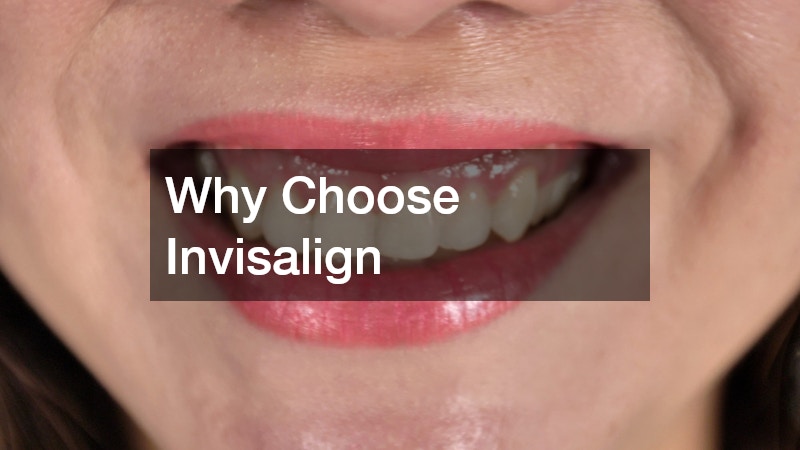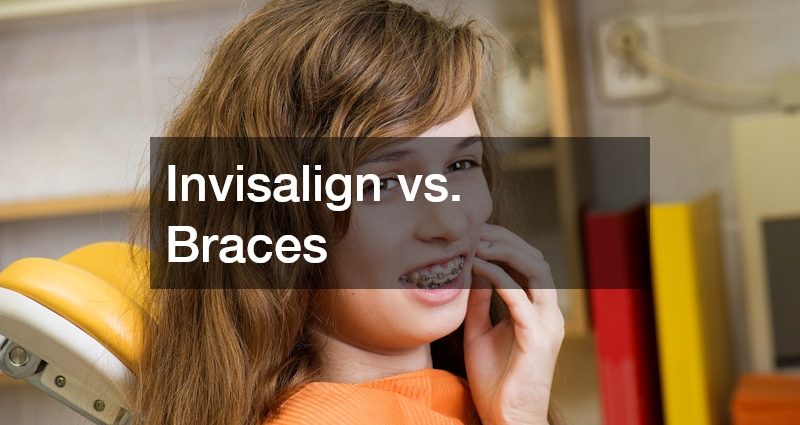
When it comes to achieving a straighter, more confident smile, two of the most popular orthodontic treatments are Invisalign and traditional braces. While both methods are effective, they differ in appearance, comfort, maintenance, and cost. Understanding these differences is key to choosing the option that best fits your dental needs, budget, and lifestyle. This guide explores how Invisalign compares to braces in terms of how they work, what they cost, and how they feel throughout treatment.
How Do Invisalign and Braces Work?
Understanding Invisalign
Invisalign uses a series of clear, removable aligners that gradually shift teeth into their desired positions. Each custom-made aligner is worn for about one to two weeks before being replaced with the next in the series.
The aligners are virtually invisible, allowing patients to straighten their teeth discreetly without metal brackets or wires.
The Mechanics of Braces
Traditional braces rely on metal brackets bonded to each tooth and connected by wires that apply gentle pressure to guide teeth into place. Orthodontists make periodic adjustments to the wires to continue progress throughout treatment.
Technological Differences
Invisalign treatments use advanced 3D imaging technology to map out a digital plan from start to finish. Patients can see a virtual preview of their expected results before treatment begins. Braces, on the other hand, involve manual adjustments at each visit, and progress is tracked through in-person evaluations.
Materials Used
Invisalign aligners are made of medical-grade, BPA-free thermoplastic that’s smooth and comfortable. Braces typically use stainless steel or ceramic materials. Ceramic braces can be tooth-colored for a less noticeable appearance but are still more visible than Invisalign.
Adjustment and Maintenance
Braces require periodic tightening appointments and sometimes the replacement of broken brackets or wires. Invisalign users simply switch to new aligners at home and visit their orthodontist less frequently—usually every 6–8 weeks—to monitor progress.
What Are the Costs Involved?
Average Costs of Invisalign
The cost of Invisalign typically ranges from $3,000 to $7,000, depending on the complexity of the case, length of treatment, and geographic location.
Average Costs of Braces
Traditional metal braces generally cost between $2,500 and $6,000, though ceramic or lingual (behind-the-teeth) braces can cost more due to their materials and placement.
Factors Influencing Cost
Several variables affect pricing for both treatments, including:
-
The severity of misalignment
-
The duration of treatment
-
The orthodontist’s experience
-
Follow-up visits and retainers after treatment
Insurance Coverage and Payment Plans
Many dental insurance plans cover a portion of orthodontic treatment, whether you choose Invisalign or braces. Flexible payment plans or financing options can also help spread out costs over time.
Long-Term Financial Implications
While Invisalign may appear more expensive initially, its shorter average treatment time and reduced need for repairs or emergency visits can balance overall costs. Braces, though sometimes cheaper upfront, may require more frequent adjustments.
Which Is More Comfortable to Wear?
Comfort Levels with Invisalign
Invisalign aligners are known for their smooth, comfortable design. Because there are no brackets or wires, there’s little risk of irritation to the cheeks and gums. However, mild soreness can occur each time you switch to a new aligner as your teeth adjust.
Comfort Levels with Braces
Braces can cause some discomfort, especially after wire adjustments. The brackets and wires may also lead to occasional mouth irritation, though orthodontic wax can help alleviate this.
Eating and Oral Hygiene
One of the major advantages of Invisalign is removability. You can take aligners out when eating or brushing, meaning there are no food restrictions. Braces require more careful cleaning around brackets, and sticky or hard foods should be avoided.
Aesthetic Considerations
Invisalign is nearly invisible, making it the preferred choice for teens and adults who want a discreet solution. Braces, even when ceramic, are still visible and may affect confidence during treatment.
Adjustment Periods
Both treatments require an adjustment period. With Invisalign, speech may be slightly affected for the first few days of wear. Braces require adapting to the feeling of hardware in the mouth and increased cleaning routines.
What Are the Treatment Durations?
Invisalign Treatment Timeline
Invisalign treatment typically lasts 12 to 18 months, though minor alignment issues can sometimes be corrected in as little as six months.
Braces Treatment Timeline
Traditional braces usually take 18 to 24 months to complete treatment, depending on the complexity of tooth movement required.
Factors Affecting Treatment Length
Age, dental health, and the type of misalignment all impact duration. Patients who wear Invisalign aligners consistently (20–22 hours per day) tend to see faster results.
Typical Progress and Adjustments
With Invisalign, you’ll change aligners every 1–2 weeks. Braces adjustments occur every 4–6 weeks, where wires are tightened or replaced.
Expected Results and Milestones
Both treatments deliver lasting, reliable results when patients follow their orthodontist’s recommendations. Post-treatment retainers are essential for maintaining alignment over time.
How Effective Are Invisalign and Braces?
Effectiveness for Different Dental Issues
Invisalign is effective for mild to moderate alignment issues, including gaps, crowding, and minor bite corrections. Braces may be better suited for more complex cases involving severe misalignment or jaw issues.
Success Rates and Long-Term Outcomes
Clinical studies show that both Invisalign and braces achieve high success rates when patients adhere to treatment plans.
Comparative Studies
Many orthodontists report comparable outcomes between the two systems, though braces provide slightly more precise control for complex tooth movements.
User Experiences and Testimonials
Patients often praise Invisalign for its comfort, convenience, and appearance. Braces users highlight their reliability and effectiveness, especially for challenging corrections.
Advancements and Innovations
Modern orthodontics continues to evolve. Invisalign technology now includes attachments and SmartTrack materials that improve control and efficiency, making it suitable for a broader range of cases than ever before.
Both Invisalign and traditional braces offer proven ways to achieve a beautifully aligned smile. While braces remain a trusted solution for complex cases, Invisalign appeals to those seeking a comfortable, removable, and nearly invisible option. Ultimately, the best choice depends on your individual dental needs, lifestyle, and budget. Consulting an experienced orthodontist can help you determine whether Invisalign or braces is the ideal path to your healthiest, most confident smile.


